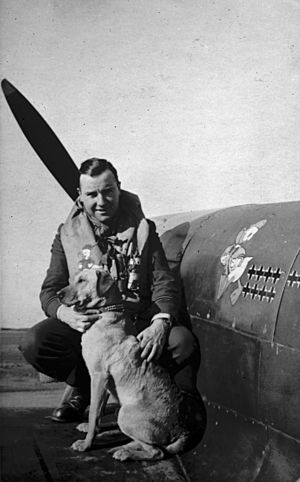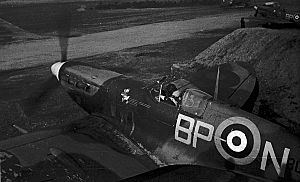John Gibson (RAF officer) facts for kids
Quick facts for kids
John Albert Axel Gibson
|
|
|---|---|

Flight Lieutenant John Gibson, on the wing of his Spitfire, early 1942
|
|
| Birth name | Axel John Albert von Wichmann |
| Born | 24 August 1916 Brighton, England |
| Died | 1 July 2000 (aged 83) Nottingham, England |
| Allegiance | United Kingdom |
| Service/ |
Royal Air Force |
| Rank | Squadron Leader |
| Commands held | No. 15 Squadron RNZAF |
| Battles/wars | Second World War |
| Awards | Distinguished Service Order Distinguished Flying Cross |
| Other work | Airline pilot and executive |
John Albert Axel Gibson, DSO, DFC (24 August 1916 – 1 July 2000) was a brave pilot in the Royal Air Force (RAF) during the Second World War. He was known as a "flying ace" because he shot down 12 enemy aircraft.
Born in Brighton, England, John moved to New Zealand with his mother when he was young. In 1938, he returned to England to join the RAF. He flew with No. 501 Squadron during the Battle of France and the Battle of Britain. He earned the Distinguished Flying Cross in 1940. Later, he served with the Royal New Zealand Air Force (RNZAF) in the Pacific, even leading No. 15 Squadron. For his bravery there, he received the Distinguished Service Order. After the war, he became an airline pilot and worked in civil aviation. He passed away in England at 83 years old.
Contents
Early Life and Joining the RAF
John Gibson was born in Brighton, England, on 24 August 1916. His birth name was Axel John Albert von Wichmann. After his parents divorced, he moved to New Zealand with his mother in 1920. He went to schools in Auckland and New Plymouth, where he was a good athlete and a champion in rifle shooting.
In 1937, John decided to join the Royal Air Force (RAF). He sailed to the United Kingdom in April 1938. Before he left, he officially changed his name to John Albert Axel Gibson. He started his flying training at Brough Aerodrome, learning to fly on Blackburn B-2 planes. He quickly passed his courses and became an acting pilot officer in July. He then continued his training at RAF South Cerney, where he learned to fly Hawker Harts. He earned his pilot's "wings" in November 1938.
World War II Flying Adventures
Fighting in France
In May 1940, when Nazi Germany invaded France, John Gibson joined No. 501 (County of Gloucester) Squadron. His squadron flew from RAF Tangmere to France to help the Allied forces. John had never flown the Hawker Hurricane fighter plane before, but he quickly learned. He helped support the Allied troops as they retreated from the German army.
On 27 May, his squadron faced 30 Heinkel He 111 bombers. John shot down one and helped destroy another. He was then shot down himself but landed safely near Rouen. He was back in action quickly! In the next few days, he shot down another He 111 and likely destroyed two more bombers. He was shot down again on 10 June over Le Mans, but not before destroying a Messerschmitt Bf 109 fighter. His squadron later helped cover the evacuation of British soldiers from Cherbourg.
The Battle of Britain
After fighting in France, No. 501 Squadron returned to England. From July 1940, they patrolled the skies over the Isle of Portland. John damaged a He 111 on 9 July. A few days later, he destroyed a Dornier Do 17 bomber.
Later that month, John's squadron moved to RAF Gravesend in Kent. They flew patrols and stopped German air raids. On 29 July, he shot down a Junkers Ju 87 dive-bomber over Dover. During a raid on 12 August, John destroyed another Ju 87. He also shot down an escorting Bf 109. When he landed, his Hurricane crashed into a bomb crater, but he was okay. Three days later, he led three Hurricanes against 20 Ju 87s and destroyed one. His own plane was hit and caught fire. He bravely stayed with the burning plane until it was clear of Folkestone town before bailing out.
On 24 August, over 50 Junkers Ju 88 bombers attacked Ramsgate. John destroyed one, watching it crash into the sea. He was promoted to acting flight lieutenant the next day. On 29 August, he shot down a Bf 109 but was then shot down himself. He parachuted into the English Channel and was rescued by a boat. The very next day, he received the Distinguished Flying Cross for his bravery. The award recognized how he steered his burning plane away from Folkestone to protect the town.
In early September, John's rank became permanent. On 7 September, the German air force launched a huge bombing attack on London. John's squadron was among those sent to fight. He likely shot down another enemy plane. Later, he was wounded in a fight and had to go to the hospital.
Flying Spitfires and Training Others
For the first few months of 1941, John's squadron switched to flying Supermarine Spitfires. These were faster and more powerful planes. In May, John was posted to No. 53 Operational Training Unit as an instructor. He helped train new pilots. Later that year, he became a permanent flight lieutenant.
In late 1941, he returned to active flying as a flight commander with No. 457 Squadron, an Australian Spitfire squadron. They patrolled over the Irish Sea and flew missions over occupied France. In May 1942, the squadron prepared to move to Australia.
Service in the Pacific
In June 1942, John was sent to New Zealand to serve with the Royal New Zealand Air Force (RNZAF). He joined the new No. 15 Squadron as a flight commander. The squadron moved to Tonga and took over American P-40 Kittyhawk planes. Their job was to defend Tonga. John returned to New Zealand at the end of the year for a staff role.
In May 1943, John was promoted to acting squadron leader. In December, he rejoined No. 15 Squadron in the Solomon Islands. He became the squadron's commander. In early 1944, his squadron supported the landings at Bougainville. On 23 January, he destroyed a Zeke (a type of Mitsubishi A6M Zero fighter) while escorting bombers over Rabaul. The squadron then went to New Zealand for a rest. They returned to the South Pacific for another tour. In August, John's time with the RNZAF ended, and he returned to Europe.
Return to Europe and End of War Service
Back in the United Kingdom, John joined No. 80 Squadron, which flew Hawker Tempest planes. They were based in the Netherlands and attacked German targets on the ground, like transport, bridges, and trains. On 16 March 1945, he received the Distinguished Service Order for his bravery in the Pacific. By this time, he had flown 382 missions and spent over 660 hours flying in combat.
On 24 March 1945, during a big operation called Operation Varsity, John's squadron supported airborne troops crossing the Rhine River. His plane was damaged by anti-aircraft fire, and he had to make an emergency landing. He was injured and had to receive medical treatment in England, which ended his active service in the war.
John Gibson was credited with destroying 12 enemy aircraft. He also helped destroy one, possibly destroyed two more, and damaged 11 others.
After the War
After the war, John officially joined the RNZAF in December 1945. However, in late 1946, he returned to the RAF. He served as a pilot for important leaders like Field Marshal Bernard Montgomery and Marshal of the Royal Air Force Arthur Tedder. He retired from the RAF on 31 December 1954.
Airline Pilot and Later Life
John Gibson moved to South Africa with his second wife, Isobel. He became a commercial pilot for the Chamber of Mines in Johannesburg. In 1965, John started his own airline called Bechuanaland National Airways.
During the Biafran War (1969–1970), John flew for Rhodesian Air Services. He flew supplies into dangerous areas and helped evacuate refugee children, often at night with few navigation tools. His son Michael sometimes flew with him as co-pilot.
Later, he formed another charter airline called Jagair, based in Kariba Dam in Rhodesia. The name "Jagair" came from his initials. He stopped his airline work in 1974 but then flew with the Rhodesian Air Force until 1979. He worked for the Department of Civil Aviation in Salisbury, Zimbabwe, until he retired in 1987. He then returned to the United Kingdom and settled in Nottingham. John Gibson passed away on 1 July 2000, at the age of 83.


